SK Telecom Rolls Out “4.5G” Service in South Korea-Plans 1G b/sec in 2018; Negative Outlook from Analysts
Executive Summary:
SK Telecom, the largest wireless telco in South Korea and first global wireless network provider to deploy LTE Advanced (aka LTE-A), has now launched a higher speed “4.5G” [Note 1.] network service in 53 cities across South Korea. The “4.5G” service delivers a speed of 700M b/sec to users that have a compatible handset (for now it’s only the Samsung Galaxy S8). The 4.5G wireless network uses 4 X 4 multiple-input and output (MIMO), which enables downloading a 2G byte movie within just 23 seconds. By using four- or five-channel carrier aggregation in conjunction with 4 x 4 MIMO, as well as other technologies that form part of the LTE-Advanced Pro standard, SK Telecom expects to be able to introduce gigabit-speed connections on its “4.5G” network in the first half of 2018.
The carrier’s “4.5G” network is expecting to reach 50 percent of its population by the end of 2017. In a statement, Choi Seung-won, SVP and head of infrastructure strategy at SK Telecom said it plan to launch 1Gb/s LTE-A pro service in the first half of 2018. See quotes from Mr Choi below.
……………………………………………………………………………………………………………………………………………………………………………………………………………………………………………………………………….
NOTE [1]: There really is no standardized “4.5G” service from ITU-R. SK Telecom is simply exploiting features in LTE-A that enable higher speeds. ITU-R originally referred to LTE as a 3G+ technology within IMT 2000. Up till 2012, “4G” was associated with IMT Advanced criteria being met. LTE-A met all the criteria of IMT Advanced.
However, wireless carrier marketeers jumped the gun when LTE was first deployed. LTE (part of ITU-R IMT 2000) was called a “4G” service by many carriers. ITU-R didn’t want to fight the marketing hype and issued this statement: “ITU does not have a definition for 4G and ITU cannot hold a position on whether or not a given technology is labelled with that term for marketing purposes.”
Thereby, faster LTE-A is now called “4.5G”by many wireless carriers to distinguish it from lower speed LTE (or LTE-A). Does that make any sense?
………………………………………………………………………………………………………………………………………………………………………………………………………………………………………………………………………..

Key points:
- SK Telecom currently owns 10 MHz in the 800 MHz band, 20 MHz in 1800 MHz, 10 MHz in 2.1 GHz and a total of 30 MHz in the 2.6 GHz range.
- Carrier aggregation, which combines two or more spectrum channels (sometimes from different frequency bands), is used to boost bandwidth to up to 700 Mb/sec.
- The 900 Mbit/s service is based on a mixture of carrier aggregation — with SK Telecom combining either three or four channels — as well as 4×4 MIMO. By using four- or five-channel carrier aggregation in conjunction with 4×4 MIMO, as well as other technologies that form part of the LTE-Advanced Pro standard, SK Telecom expects to be able to introduce gigabit-speed connections on its 4G network in the first half of 2018.
- The higher-speed services will be available only to customers with a Samsung Galaxy S8, which will be able to support the LTE-A Pro technologies following an over-the-air firmware upgrade. However, SK Telecom insists that forthcoming handsets will also be able to handle LTE-A.
……………………………………………………………………………………………………………………………………………………………………………………
Whither 5G?
Some analysts are asking if 5G is really needed once SK Telecom and other carriers roll out 4.5G with speeds up to 1 Gb/sec. There is intense rivalry in South Korea’s mobile Internet market as operators attempt to outperform one another on connection speeds.
Many proponents of 5G have responded to such criticism by drawing attention to the technology’s other attractions, including much lower latency, or network delay, than is found in a 4G system.
With 5G techniques such as network slicing, operators will also be able to provide many different types of network service over the same 5G infrastructure.
SK Telecom is keen to present its latest “4.5G” moves as a kind of stepping stone to the 5G standard, which it has talked about introducing in trial form in time for next year’s Winter Olympics in PyeonChang. (See SKT Airs 28GHz Concerns, Eyes Mid-Band 5G.)
“SK Telecom’s LTE-A Pro services represent an early application of 5G technologies that support Gbit/s-level data speeds and massive network capacity,” said Choi Seung-won, a senior vice president at SK Telecom and head of its infrastructure strategy office, in a company statement. “4.5G can be considered as the very last stage of LTE and will facilitate the spread of immersive multimedia services, including virtual reality, augmented reality and 3D hologram content.” The SK Telecom executive also said he expected the investments in LTE-A Pro to give SK Telecom a “valuable edge in the 5G era.”
http://www.lightreading.com/mobile/lte-a-pro/sk-telecom-moves-closer-to-1gbit-s-4g/d/d-id/733419
……………………………………………………………………………………………………………………………………………………………………………………………
Wireless Network Analyst Opinions:
- According to Bengt Nordström, CEO of consultancy Northstream, telcos are not innovating and the wireless network business will contract over the next few years:
“The trend which we are likely to see over the next couple of years is the deterioration of revenues, because what telcos are bringing to the market is fairly commoditized and very similar to competitors. But there is an upside, the cost structures are too high.
“They can do what they do today and even better, by trimming the organization such as replacing legacy equipment and processes or hiring and retraining new people. They can still maintain margins even though top-line revenues are shrinking.”
“If I were a (wireless network equipment) vendor I would base my business plan on the equipment market being smaller in the next five to seven years,” Mr. Nordstrom told Light Reading.
Of course, the reason for that is that the LTE and incremental LTE Advanced global roll-outs are slowing and that volume 5G (IMT 2020) won’t start to be deployed till 2021 or 2022. Hence the next few years will see flat or negative growth in sales for wireless network equipment.
2. The dismal forecast for cellular network equipment was earlier made by
“The mobile infrastructure market outlook remains cloudy as 2017 brings us 2 years past the LTE peak, with fewer and fewer potential 2G/3G mobile networks that need to be upgraded to LTE. In the Q4 edition of our Mobile Infrastructure Market Tracker – Regional, released 1 December 2016, we had 537 live commercial LTE networks and a total of 560 in the forecast for the full year. As we believe there are roughly 750+ mobile networks worldwide and those left with no LTE have small footprints in the range of fewer than 1,000+ nodes, the LTE infrastructure hardware market is poised for steep decline this year.
Telecom spending (CAPEX) appears to be very flat at best! Little has changed since last year, and in our most recent biannual Service Provider Capex, Revenue, and Opex Market Tracker – Regional report, released in November 2016, we still expect worldwide capex to barely budge from $341.5B last year to 342.8B by year end—just 0.4% YoY growth.”
Parks Associates: >75% of U.S. households use WiFi for in home connectivity
Parks Associates reports that more than 75% of data in U.S. homes is carried via Wi-Fi connectivity. Wi-Fi is doing the large majority of work when it comes to home networking and data transport in U.S. broadband households amid ongoing rapid growth in network usage and data consumption, Parks’ senior director of research Harry Wang highlighted.
Half of US broadband households use 3G and 4G wireless services for Internet connectivity, followed by Ethernet cabling and network connections (like DSL or cable modems) as per the chart below:
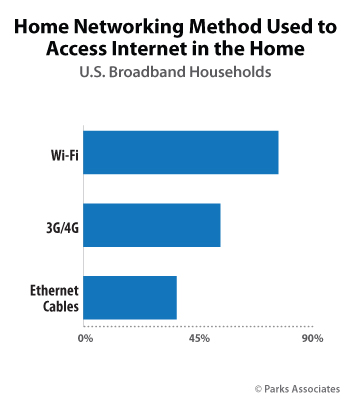
In-Home Wireless Data:
“Consumers already use lots of data on their mobile, smart home, and entertainment devices, and Wi-Fi is doing most of the work in the home, accounting for more than 70% of data used per month in U.S. broadband households,” Wang was quoted in a press release.
Furthermore, according to Parks Associates’ latest IoT-related research:
- Roughly 50% of U.S. broadband households are willing to share data from smart devices for discounts on electricity, and 40% are willing to share data to update and improve their products.
- More than 75% of U.S. broadband households use Wi-Fi for connectivity in the home and 50% report using 3G/4G services.
- 40% of broadband households in Canada use a personal assistant device or app.
Consumer demand for data will continue to grow both inside and outside the home, Wang noted. So will the number of network devices acquired in U.S. households, which Wang says is expected to rise to more than 2.3 billion between 2015 and 2020.
“Providers and manufacturers must ensure their offerings can deliver a positive user experience despite these increasing demands—and that they are positioned to leverage new revenue opportunities emerging from the connected home,” he cautioned.
Reference:
http://www.parksassociates.com/blog/article/pr-05312017
For more information on Parks Associates research or events, visit www.parksassociates.com, or contact [email protected], 972-490-1113. To schedule an interview with an analyst or to request specific research data, please contact Holly Sprague at [email protected] or 720-987-6614.
Akamai: U.S. Internet speeds increased 22% YoY; IPv6 adoption is a conundrum
Introduction & Overview:
Average Internet connection speeds in the U.S. rose by 22% in the past year and up 8.8% from the previous quarter. That was good enough to move the U.S. from 14th to 10th in the world rankings, according to Akamai’s quarterly State of the Internet report.
This quarter’s report includes data gathered from across the Akamai Intelligent Platform during the first quarter of 2017, covering internet connection speeds and broadband adoption metrics across both fixed and mobile networks, as well as trends seen in this data over time. In addition, the report includes insight into the state of IPv4 address exhaustion and IPv6 address adoption, Internet events and disruptions that occurred during the quarter, and observations from Akamai partner Ericsson regarding data and voice-traffic growth on mobile networks. We present selected highlights of Akamai’s report in this blog post. Slow IPv6 adoption is a conundrum in light of IPv4 address exhaustion.
Global Average Connection Speed = 7.2 Mbps
Global Average Peak Connection Speed = 44.6 Mbps
Connection Speeds & Broadband Adoption:
U.S. speeds averaged 18.7 megabits per second compared with 28.6 Mbps for global leader South Korea. Other global leaders included Norway (23.5 Mbps), Sweden (22.5 Mbps), Hong Kong (21.9 Mbps) and Switzerland (21.7 Mbps).
The worldwide 10 Mbps, 15 Mbps, and 25 Mbps broadband adoption rates all saw robust quarter-over-quarter growth, increasing 9.0%, 11%, and 16% to adoption levels of 45%, 28%, and 12%, respectively. As it has for many quarters, South Korea continued to lead the world in all three broadband tiers, with adoption rates of 85%, 69%, and 40% respectively, after quarterly increases of 3.1%, 7.8%, and 16%.

Washington, D.C. once again had the U.S.’s highest broadband adoption rate of 25 Mbps or more.
According to Broadband Reports, fiber optic Internet is only available to 1% of Santa Clara County residents (no Google Fiber of Verizon FioS here) and 0% of Santa Clara city residents (including this author) have residential fiber optic Internet service. The two primary broadband carriers in the county are Comcast Xfinity and AT&T U-verse. Both offer triple play service bundles.
Mobile:
In the first quarter of 2017, average mobile connection speeds (aggregated at a country/region level) ranged from a high of 26.0 Mbps in the United Kingdom to a low of 2.8 Mbps in Venezuela. Based on traffic data collected by Ericsson, the volume of mobile data traffic grew by nearly 12% over the previous quarter.
In the first quarter of 2017, 62 surveyed countries/regions around the world qualified for inclusion in the mobile section, up from 61 in the fourth quarter of 2016. Figure 38 shows that across these countries/regions, the United Kingdom once again had the fastest average mobile connection speed at 26.0 Mbps (down from 26.8 Mbps in the fourth quarter), with Germany again in second place at 24.1 Mbps. Venezuela again had the lowest average connection speed at 2.8 Mbps (down from 2.9 in the fourth quarter), followed by Namibia, with an average connection speed of 3.8 Mbps. Among the qualifying surveyed countries/regions, 32 in total had an average mobile connection speed at or exceeding the 10 Mbps broadband threshold (up from 30 in the previous quarter), while 60 achieved average speeds at or above the 4 Mbps broadband level (up from 58).
Within the individual continental regions, the following qualifying surveyed countries/regions had the highest average mobile connection speeds:
• Americas: United States, 10.7 Mbps
• Asia Pacific: Australia, 15.7 Mbps
• Europe: United Kingdom, 26.0 Mbps
• Middle East/Africa: Kenya, 13.7 Mbps
Continuing the trend of quarters past, the first quarter of 2017 saw rapid gains in mobile networks, from 4g and lte-a deployments to 5g developments. After many delays, 4g services finally launched in Egypt in the first quarter,51 while in New Zealand, the government revealed that 90% of the country’s population now had access to 4g mobile services, roughly two years ahead of schedule, due to aggressive rollouts by mobile providers Vodafone New Zealand and Spark.
According to Broadband Search, the average download speed for all wireless Internet providers in Santa Clara, CA (the center of Silicon Valley and this author’s home town for 47+ years) is 4 Mbps and the maximum download speed available is 10 Mbps . The upload speed average via wireless Internet providers in Santa Clara is 4 Mbps,
IPv6 Adoption:
Insight into IPv6 adoption is based on data gathered from the Akamai Intelligent Platform. Akamai is now finding that lack of IPv6 support in some consumer electronics (such as smart TVs and stand-alone digital media player devices) is presenting a barrier to growth in adoption, especially as the amount of content consumed on these devices grows over time. While not all of Akamai’s customers have chosen to implement IPv6 delivery yet, the data set used for this section includes traffic from a number of leading web properties and software providers, so we believe it is sufficiently representative. Note that in compiling the data for the figures in this section, a minimum of 90 million total requests to Akamai during the first quarter was required to qualify for inclusion.
European countries continued to lead IPv6 adoption, taking six of the top 10 spots. The four non-European countries among the top 10 included the U.S., Trinidad and Tobago, India, and Brazil. Belgium remained the leader with 38% of connections to Akamai via IPv6, 13% higher than second place Greece.
In the first quarter, despite a 19% quarterly drop in IPv6 adoption, Belgium maintained its substantial global lead, as 38% of its dual stack content requests to Akamai were made over IPv6. Belgium’s IPv6 percentage was 13 points higher than Greece, in which held second place. Unlike the fourth quarter of 2016, when 9 of the top 10 countries/regions recorded a rise in IPv6 adoption, in the first quarter of 2017, 8 of the 10 posted declines, though these changes may be explained in part by the cyclical seasonal effects noted above. Drops ranged from 4.8% in the United Kingdom and Trinidad and Tobago to 22% in Switzerland. India and Brazil were the two countries in the top 10 to see quarterly gains, as their adoption levels rose 21% and 29% respectively.
Once again, cable and wireless/mobile providers continued to drive the largest volumes of IPv6 requests, as many are leading the way for IPv6 adoption in their respective countries. In the first quarter of 2017, T-Mobile caught up to Verizon Wireless to share the lead in adoption rates, as both providers had 82% of their requests to Akamai being made over IPv6, up from 77% and 81% respectively in the fourth quarter. Sixteen of the top twenty providers had at least one in four requests for dual-stacked content to Akamai take place over IPv6—down from 17 providers in the fourth quarter. All but one of the top 20 had at least 15% of dual-stack content requests to Akamai occur over IPv6. First-quarter news announcements reflected the leadership role mobile carriers are continuing to play in IPv6 adoption. In Japan, three major mobile carriers—NTT Docomo, KDDI, and Softbank —revealed they would start full IPv6 services in 2017.
In the u.s., Verizon Wireless informed customers that beginning on June 30, 2017, it would cease to issue new IPv4 addresses. From that point forward, Verizon customers requesting new static public IP addresses will be issued IPv6 addresses only.
References:
Apple to test “5G” in Cupertino & Milpitas, CA, but which RAN/Modulation Scheme?
Apple has applied for an experimental license from the FCC to test next-gen “5G” wireless technologies, according to a report from Business Insider and an article in USA Today which wrote:
It’s hardly a surprise that Apple would be pursuing a path to 5G. The promise of this next generation of wireless is that smartphone makers might eventually achieve blistering wireless data speeds of 1 gigabit per second and beyond, along with low latency and other potential benefits. In the U.S., Verizon, AT&T and T-Mobile are all chasing their own 5G future—and each other.
Apple indicates that it plans to test 5G technologies in two locations in controlled facilities, one in Cupertino and another in Milpitas, California. Apple said that it plans to use the 28 and 39 GHz bands via technology provided by Rohde & Schwarz, A.H. Systems and Analog Devices.
Apple’s FCC application reads in part:
Apple Inc. seeks to assess cellular link performance in direct path and multipath environments between base station transmitters and receivers using this spectrum…These assessments will provide engineering data relevant to the operation of devices on wireless carriers’ future 5G networks.
Apple respectfully requests that the Commission grant its request for an experimental license for operations in accordance with Section 5.3(j) of its rules.2 Apple intends to transmit from two fixed points located at Apple-controlled facilities in Cupertino and Milpitas, CA. These transmissions will be consistent with the parameters and equipment identified in Apple’s accompanying Form 442, and will include the use of a horn antenna with a half-power beamwidth of 20 degrees in the E-plane and H-plane and a downtilt between 20 – 25 degrees. Apple anticipates that it will conduct its experiments for a period not to exceed 12 months.
The transmitting equipment Apple intends to use is incapable of station identification. Because Apple will coordinate its operations with existing microwave users in the area, Apple respectfully requests that the Commission exempt this authorization from the station identification requirements.
………………………………………………………………………………………………………………………………………………………………………………….
Light Reading earlier reported Apple to be hiring at least one engineer with knowledge and experience of “radar signal processing,” which implies the signals which are used in millimeter wave transmissions. Millimeter wave is the band of spectrum between 30 GHz and 300 GHz. The ITU-R WP 5D/IMT 2020 standards committee has proposed 30 GHz to 86 GHz for use by 5G networks (see below).
……………………………………………………………………………………………………………………………………………………………..
“5G” Carrier Specific vs ITU-R IMT 2020 Standard?
Since Apple’s application notes that it “will conduct its experiments for a period not to exceed 12 months.” Consequently, it stands to reason that the 2019 iPhone 9 will be the first iPhone with “5G” connectivity. But what version of “5G” will that be?
A few months ago, AT&T and Verizon said that they will begin rolling out their own (non standard, carrier specific) 5G networks late this year and in 2018. That’s before ITU-R WP 5D/IMT2020 standards committee will decide on the Radio Access Network (RAN) to be used for true 5G. End point devices made for AT&T’s “5G” network won’t work on Verizon’s and vice-versa. Apple (and other smart phone/tablet makers) will likely delay the release of a volume production 5G iPhone until overall 5G coverage becomes widespread.
On May 25th, Wang Xinhui, Director of Wireless Standardization and Industrial Relationships at ZTE Corporation, said wireless telecommunications operators should work towards to incubate globally harmonized ecosystem for 5G mobile communication in the interests of the healthy development of the telecommunications industry. In an address to the 3rd Global 5G Event in Tokyo, Mr. Wang said industry standardization for mobile broadband and the Internet of Things should move forward in parallelism, in order to drive adoption by different industries and economic sectors. Mr. Wang is also Vice Chair of International Cooperation of the IMT-2020 (5G) Promotion Group. Mr. Wang said that 5G should meet the requirements of eMBB (enhanced Mobile Broadband), URLLC (Ultra-Reliable and Low Latency Communications) and mMTC (massive Machine Type Communications), supporting greater mobility and seamless coverage. Industry participants globally should collaborate in a more open manner to build unified standards and industry ecosystems. [This author doesn’t see such co-operation amongst wireless carriers in the U.S.]
ZTE has signed strategic partnerships on 5G development with the world’s top telecommunications carriers including Deutsche Telekom, Telefonica, SoftBank, KT Group, China Mobile, China Telecom and China Unicom.
…………………………………………………………………………………………………………………………………………………………………….
From an ITU-R press release this past February:
“The IMT-2020 standard is set to be the global communication network for the coming decades and is on track to be in place by 2020. The next step is to agree on what will be the detailed specifications for IMT-2020, a standard that will underpin the next generations of mobile broadband and IoT connectivity,” said François Rancy, Director of ITU’s Radiocommunication Bureau.
We can anticipate that there will now be a number of early technical trials, market trials and deployments of 5G technologies based on the foreseen developments slated for IMT-2020. These systems may not provide the full set of capabilities envisaged for IMT-2020, but the results of these early activities will flow forward into, and assist the development of, the final complete detailed specifications for IMT-2020.
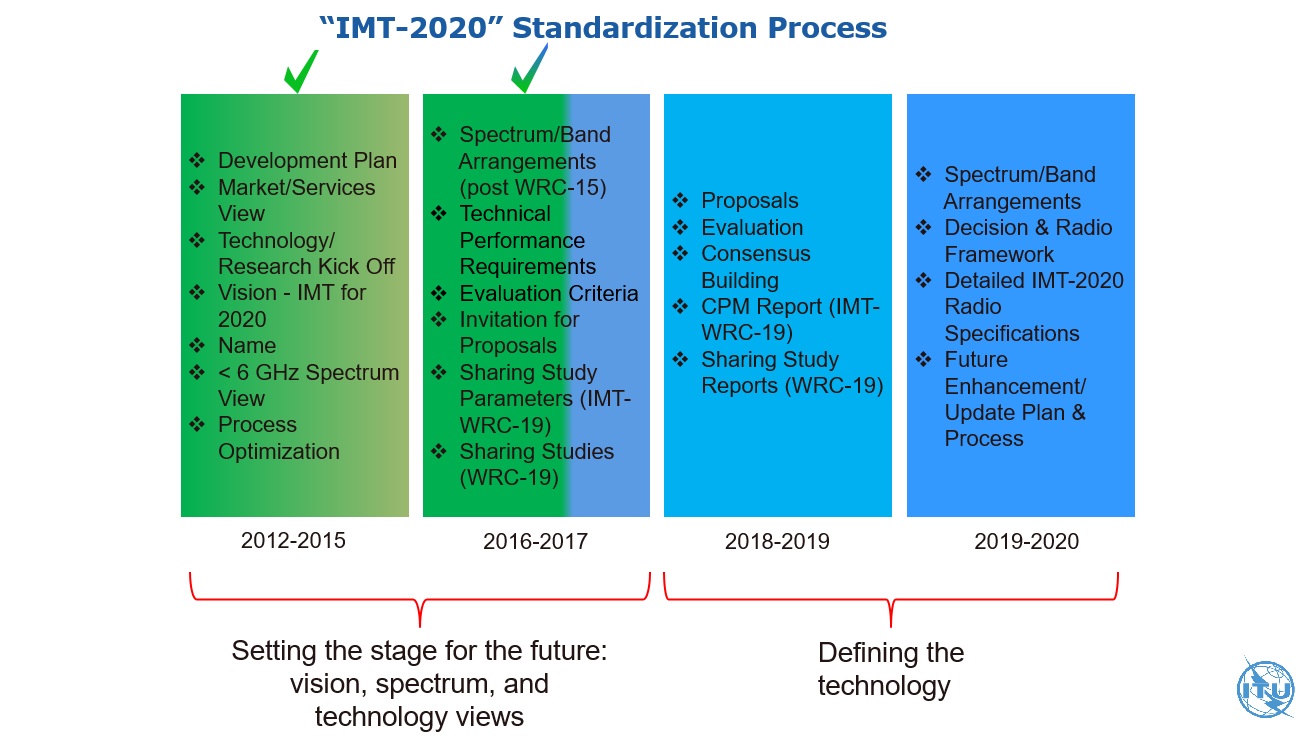
…………………………………………………………………………………………………………………………………………………………………………………………….
5G Frequency Spectrum:
During the World Radiocommunication Conference (WRC) 15, the ITU proposed a set of global frequencies for 5G, which it intends to finalize at the next conference in 2019 (WRC 19):
24.25–27.5GHz
31.8–33.4GHz
37–40.5GHz 40.5–42.5GHz
45.5–50.2GHz 50.4–52.6GHz
66–76GHz
81–86GHz
In 2014, the FCC published a Notice of Inquiry into use of spectrum bands above 24 GHz for Mobile Radio Services, 80 followed by a Notice of Proposed Rulemaking in October 2015, which listed the following potential bands for 5G in the United States.
27.5-28.35 GHz (28 GHz band)
37.0-38.6 GHz (37 GHz band)
38.6-40 GHz (39 GHz band)
64-71 GHz (unlicensed use)
70/80 GHz Bands: 71-76 GHz, 81-86 GHz
The FCC issued adopted rules to identify and open up 5G spectrum allocation in July 2016 that identify 3.85 GHz of licensed spectrum and 7 GHz of unlicensed spectrum: licensed use in 28 GHz, 37 GHz, and 39 GHz bands; unlicensed use in 64-71 GHz; and shared access in the 37-37.6 GHz band.
Reference:
……………………………………………………………………………………………………………………………………………………………………………….
Forrester Research: IoT Upsets Application Development- Hello Streaming & Machine Learning!
by Mike Gualtieri of Forrester Research (adapted from Forrester Research white paper “IoT Upsets Application Development”)
Overview:
This is a follow on to the recent IoT post: Cisco Study: Few IoT projects survive proof-of-concept stage; Electric Imp on why not?
………………………………………………………………………………………………………………………………………………………………………………….
Internet of things (IoT) is the latest transformational technology, extending ubiquitous connectivity and control to the physical world. The applications are limited only by our imagination and our ability to build both cloud-based and enterprise infrastructure to deal with the flood of data and interactions that IoT represents.
Because The IoT Spigot Is Always Open, App Development Teams Need A New Stream-Driven, Machine Learning Approach! That’s explained in this article.
Key Takeaways:
- IoT Apps Blur And Bridge Physical And Digital Worlds: IoT applications comprise a collection of devices that may have sensors and/or actuators that bridge the digital and physical worlds, which can turn contextual information from sensors into insight and action.
- Hello, Streaming: Forget most of what you have learned about app development. If you want to design IoT applications, you need to design apps that can ingest and analyze streaming data in real time.
- Hello, Machine Learning: Machine learning can analyze sensor and action data from devices to automatically improve program logic to make an app smarter over time.
IoT Applications Turn Real-World Context Into Physical Action:
Typical enterprise applications are “request and response.” AD&D pros design apps to get input from users, process the request, and then respond to it. These traditional apps are user-driven. That approach is insufficient for IoT applications because IoT applications must be ready to receive and react to information from device sensors and actuators, typically in real time. IoT applications help companies bridge the physical and digital worlds, turning contextual information from sensors into insights and action.1 IoT applications comprise a collection of devices that may have sensors only, actuators only, or both sensors and actuators. This is a system of connected devices that can provide applications with context, actuation, and learning.
- Context: a view of the physical world. IoT sensors measure physical parameters of people, places, or things. They emit live data such as motion, temperature, voltage, pressure, audio, video, and position, with the list going on and on. This information from a system of IoT sensors can provide applications with real-time context — what is happening right now at a single physical sensor and what is happening right now among all of the sensors in the system. That can be an amazing amount of contextual information that traditional applications can’t handle.
- Actuation: the ability to change the physical world. IoT actuators make something happen in the physical world such as opening a lock, instructing a furnace to turn down the heat, or displaying customized context within an app. IoT applications that include IoT actuators make changes to the physical world, often in real time.
- Learning: an increasing corpus of knowledge. IoT apps gather a tremendous amount of information from device sensors and generate log data about actuation commands and their results in the physical world. This data can be input to machine learning algorithms and advanced analytics to improve the application’s decision with every iteration
IoT Applications Are Stream-Driven:
Stream-driven means that data can drip periodically like dew from a leaf, pour down like the mighty Niagara Falls, or flow continuously like the Danube from one or many devices into an IoT application. The IoT application uses some of this data immediately to actuate devices, and it stores the rest of it to analyze later.2 The Nest thermostat is a classic easy-to-understand example. It continuously receives temperature, humidity, and motion data from the home sensor and uses that to actuate the heating or cooling system. It also uses the data to learn about the home owner’s habits and make automatic adjustments (e.g., based on patterns of travel).
Other IoT applications are more complex than that because they rely on many more devices and much more complex logic. But most require an application architecture that responds to streams of sensor data that help these components work in unison.
Multiple IoT devices. An IoT application must have a way to communicate with the devices that comprise the system of devices for the IoT application. IoT device connectivity and management solutions provide two-way communication and device control.
Stream ingestion and analytics. Sometimes, data spikes fast and furiously, and at other times, it drips in. IoT applications must be able to ingest data from IoT devices at the rate that it is emitted. Ingestion, however, is not enough. Streaming solutions must also be able to analyze data in real time. Many of these platforms also have smaller footprint versions that can perform ingestion and analytics at the edge — that is, you can deploy them on an IoT device. To help AD&D pros learn more about streaming ingestion and analytics, Forrester evaluated 15 vendor solutions in this space, including some vendors that offer commercial versions of open source, in a recent Forrester Wave™ report.
Machine learning. To know and not to do is not yet to know. That ancient proverb sums up the importance of including an advanced analytics regime in your IoT applications. Advanced analytics that uses machine learning can create predictive models or materialize other analytics that you can use in the IoT application’s logic. You can dump all of the data that comes from the IoT devices and all of the actuations that the application takes into a data lake for analysis to create models that the IoT applications can use. Creating a data lake in Hadoop and then using Apache Spark for advanced analytics is becoming increasingly common for implementing advanced analytics.
Actuation controller. IoT applications must trigger an action in the physical world. An IoT application must be able to issue commands to devices with actuators to make those devices do something such as open a gate, turn on a camera, or change the speed of a delivery drone.
Logic. The brain of an IoT application is the current context, programmed logic, and learned logic. The current context is a data model that represents the current situation that the sensors in the IoT devices report and any relevant external context from other applications. The simplest of current context might be that the room temperature is 66 degrees Fahrenheit. The programmed logic continuously monitors the current context and takes actions as necessary. Simple programmed logic could be that if the temperature drops below 68 degrees Fahrenheit, then the heat goes on. Additional programmed logic could be that the heat goes off when the temperature is 2 degrees higher than the target temperature of 68 degrees Fahrenheit. Learned logic modifies the programmed logic by analyzing the data and behavior of the application over time. Learned logic comes from advanced analytics and machine learning algorithms that recognize repeated patterns and turn those into logic.
Cisco Study: Few IoT projects survive proof-of-concept stage; Electric Imp on why not?
Only a minority of internet of things (IoT) projects get past the proof-of-concept stage, according to a Cisco study that also says just 26% of companies report completely successful IoT initiatives.
“It’s not for lack of trying,” said Rowan Trollope, Senior Vice President and General Manager, IoT and Applications, Cisco. “But there are plenty of things we can do to get more projects out of pilot and to complete success,” he added.
According to the study, the top five challenges across all stages of implementation were time to completion, limited internal expertise, quality of data, integration across teams, and budget overruns. The study found that the most successful organizations engage the IoT partner ecosystem at every stage of the IoT implementation plan, which implies that strong partnerships throughout the process can smooth out the learning curve. Another key finding was that 64% of surveyed decision-makers agreed that learnings from stalled or failed IoT initiatives have helped accelerate their organization’s investment in IoT.
“We are connecting things that we never thought would be connected, creating incredible new value to industries. But where we see most of the opportunity, is where we partner with other vendors and create solutions that are not only connected but also share data,” said Inbar Lasser-Raab, VP of Cisco Enterprise Solutions Marketing. “That shared data is the basis of a network of industries – sharing of insights to make tremendous gains for business and society, because no one company can solve this alone.”
Almost two thirds of all participants in the survey said they are using data from IoT completed projects to improve their business, the study revealed. Globally the top three benefits of IoT include improved customer satisfaction (70%), operational efficiencies (67%) and improved product/service quality (66%).
Cisco said that the “human factor” is key for the success of IoT initiatives. Human factors like culture, organization, and leadership are critical. In fact, three of the four top factors behind successful IoT projects had to do with people and relationships, the study said. These key factors are collaboration between IT and the business area of the companies, a technology-focused culture, and IoT expertise. In addition, organizations with the most successful IoT initiatives leveraged ecosystem partnerships most widely, Cisco’s study said.
References:
https://blogs.cisco.com/news/ciscos-new-iot-platform-will-take-your-projects-past-proof-of-concept
………………………………………………………………………………………………………………………..
Author’s Note:
The points made in this Cisco study were earlier revealed by Electric Imp’s Hugo Fiennes in his presentation: “Why are 70% of IoT Projects Stuck in PoC Purgatory?” delivered at the IoT Developers Conference, April 26-27, 2017 in Santa Clara, CA.
“To prove the value, and explore the interactions, the PoC has to be a lot more than a “connected thing”. It has to fulfil the business needs on a small scale. Only then can the risks and rewards be evaluated,” Mr. Fiennes said. “Because good IoT is outcome driven, early data often changes the direction of a PoC – simply because you’re uncovering the previously unknown,” he added. Continuing, Hugo said: “Flexibility in all aspects is key, to allow you to iterate on the basic concepts and go in new directions if needed. This allows the project’s design to be refined whilst the process is low risk and cheap.”
Hugo claimed the top three issues slowing IoT deployment were: security, integration, and implementation complexity. Security is the top organizational concern companies have with pursuing IoT solutions, but complexity of integration with existing systems, the expense and complexity of implementation are also important concerns for many organizations.
Perhaps the biggest obstacle is the inability to prove value in the PoC / field trial scope and budget.
Generally the issues here are issues with implementation and integration. In particular:
– You need to be able to develop and deploy quickly and cheaply.
– If the data can’t get reliably from where it’s created to where it’s consumed, it’s hard to prove value.
Hugo opined that “Cloud integrations are hard, because every application is unique.” There’s an urgent need for IoT applications to be robust and scale; use multiple services and be able to change over time, he said. Flexibility is key.
The second big hurdle to overcome is the ability to move confidently from trial to production. Security, maintainability, cost and completeness are the key issues here.
And of course, security is a huge concern for IoT applications as we’ve noted for many years.
“Security is a special challenge for IoT. IoT systems operate across the public internet; are deployed outside of the physical control of the organization; may remain in place in critical systems for 10 to 20 years; and may control critical infrastructure, or be capable of coordinated attacks on other systems. Furthermore, IoT developers are focused on business problems and may not have a strong security perspective. The devices themselves may lack critical hardware capabilities for securing their operation against attack. Securing IoT requires a balance of protecting against long term devastation and accelerating value generation…
Source: ”Internet of Thing Primer for 2017,’ by Gartner Group
Combined FTTH and DSL spending set to slow until 10 Gbps PON and G.fast deployments
By Jeff Heynen of SNL Kagan
After a record year in which total estimated revenue for combined digital subscriber line, or DSL, and fiber-to-the-home, or FTTH, network infrastructure reached $9.77 billion worldwide, 2017-2019 should produce a slowdown in spending. Kagan, a media research group within S&P Global Market Intelligence, is forecasting a trough being driven by expected slowdowns in 1G EPON and 2.5G gigabit passive optical networks (GPON) spending as operators wait for 10Gig technologies, including XGS-PON to become more widely available. Equipment revenue is expected to drop to $9.43 billion in 2017, $8.98 billion in 2018 and $8.80 billion in 2019, as optical line terminal, or OLT, purchases for network expansion slow and prices for current-generation technologies continue to decline.
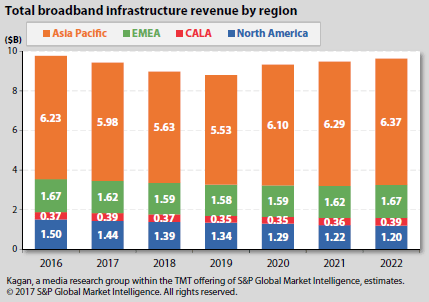
The vast majority of revenue will continue to come from the APAC region, specifically China, where China Telecom Corp. Ltd., China Unicom and China Mobile benefit from favorable regulatory policies designed to reduce FTTH construction and installation costs to help achieve national penetration and average bandwidth per user goals. Of the 95 million FTTH optical network termination, or ONT, units shipped in 2016 throughout the APAC region, we estimate that 83.5 (80.1 million) shipped to China. We expect total ONT shipments to the main Chinese operators will continue to stay in the 75 million to 80 million range through 2020, as the operators look to replace aging units with more integrated gateway units.
North American FTTH equipment spending was up 30% in 2016, surpassing $1.12 billion in equipment revenue, a first for the region and an indisputable challenge to the assertion that broadband spending in the region has declined. Total spending in North America was driven by 2.5G GPON equipment purchases at Verizon Communications Inc., AT&T Inc., Alphabet Inc.‘s Google Fiber and a growing number of tier 3 operators. Demand for new equipment is being driven primarily by Verizon, which is adding new FiOS subscribers and updating older GPON ONT models, and AT&T, which continues to expand its GPON-based AT&T Fiber footprint. But other operators, including CenturyLink Inc., Windstream Holdings Inc., Frontier Communications Corp. and Telephone and Data Systems Inc., continue to transition a growing percentage of their network footprint to fiber. However, we do believe that some of these initiatives, particularly Verizon’s FiOS upgrades, will slow after the peak in 2016, pushing revenue down to $1.07 billion in 2017 and $999.4 million in 2018.
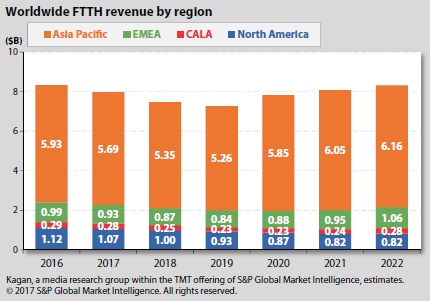
2.5G GPON remains the workhorse FTTH technology on a global basis, with operators including Verizon, AT&T, China Telecom, China Mobile, China Unicom, Telefónica S.A. and many others relying on the technology for their residential FTTH deployments. We expect 2.5G GPON will remain the leading technology choice through 2021, as ONT shipments to support subscriber growth on existing networks remain high, despite the increased rollouts of XGS-PON and NG-PON2 technologies over time.
Saturation, waiting on 10G, and a focus on 5G will keep revenue growth in check
Though 2016 was a strong year for FTTH equipment revenue, it is likely to be the peak throughout our forecast period. In 2017, revenue is expected to decline from $8.33 billion to just under $8 billion. Chinese operators are expected to slightly slow their OLT rollouts after seven straight years of phenomenal growth. Their focus will be less on new FTTH network expansion and more on continued subscriber acquisition, which will result in continued spending on ONT units. Also, the three main Chinese operators will be rolling out 10G EPON and 10G GPON equipment, as they wait on XGS-PON equipment availability. The focus will be on improving bandwidth in major metropolitan areas, especially among subscribers currently served by fiber-to-the-building (FTTB) + local area network (LAN) architectures, which typically max out at 10 Mbps downstream.
In North America and Western Europe, FTTH network buildouts, measured in the number of new OLT ports shipped, will slow after 2018, when a combination of factors are expected to reduce overall investment levels:
* Many operators will have reached saturation levels within their core FTTH networks. Like Verizon, these operators will hold off on additional territory expansions and instead focus on securing subscribers within their existing serving areas. The net result will be declining OLT shipments and sustained ONT unit shipments.
* Operators will wait until 10G variants of PON technologies become more widely available and therefore less expensive, particularly 10G EPON for cable operators, XGS-PON, which delivers symmetric 10 Gbps of throughput and NGPON-2, which delivers up to 40 Gbps of symmetric throughput.
* Finally, operators will begin shifting their spending toward preparing for upcoming 5G wireless networks. The early stages of 5G network buildouts will focus on metro areas and will rely on existing fiber connections for backhaul purposes.
Beginning in 2020, overall spending on FTTH equipment is expected to pick back up, based on increased shipments of 10G EPON, XGS-PON and NGPON-2 equipment to support upgrades to first-generation FTTH networks, business services and the backhaul of 5G wireless network traffic. By 2022, we expect total FTTH equipment spending to be $8.32 billion, nearly equal to the 2016 peak.
In a change from our October forecast, we now expect XGS-PON to become the leading next-generation technology during our current forecast period. Previously, we had expected that NGPON-2, driven by anticipated deployments at Verizon, China Telecom, and others would become the leading next-generation technology. However, after conversations with service providers, equipment vendors and component suppliers, we do not see NGPON-2 equipment, with its reliance on expensive, tunable optics, becoming widely deployed for FTTH applications until 2021 and beyond.
In our previous forecast, we expected worldwide revenue for NGPON-2 equipment in 2021 to reach $2.20 billion. We now expect it to reach just over $1 billion in 2021, with much of the revenue coming from Verizon, as it upgrades its FiOS network. By 2021, portions of Verizon’s FiOS network will be over a decade old. And with cable operators’ aggressive deployments of DOCSIS 3.1 technologies, Verizon will be forced to switch to NGPON-2 to provide a bandwidth advantage for the next decade. In addition, Verizon is expected to rely on NGPON-2’s ability to deliver multiple wavelengths to support the backhaul of mobile data traffic from its 5G base stations. A single NGPON-2 OLT can theoretically split multiple wavelengths for residential services, mobile backhaul and business services.
While Verizon is expected to stick with its plan to move to NGPON-2, a larger number of operators around the world will opt for XGS-PON, beginning in late 2017, but picking up steam in 2019. XGS-PON uses fixed optics and wavelengths, like current GPON technologies, but also provides an upgrade path to tunable optics for operators that want to move to NGPON-2 down the road.
Many operators have a 5-year goal of getting symmetric 10 Gbps services out to their customers, which would provide them an edge over cable competitors who will likely be stuck with asymmetric services through at least 2020, when full duplex DOCSIS 3.1 equipment becomes available. XGS-PON gives them the ability to deliver symmetric 10 Gbps services at price levels that are currently 4x 2.5G GPON equipment prices, as opposed to the minimum 10x 2.5G GPON costs currently seen for NGPON-2 equipment. FTTH is an expensive proposition as-is, with labor and operational costs generally consuming 70% of the budget. Equipment costs have to be controlled in order to ensure reasonable payback periods for network operators. Right now and for at least the next two years, NGPON-2 equipment will simply be too much cost to bear for most operators. Hence, the growing interest in XGS-PON among operators including AT&T, China Telecom and a growing list of tier 2 and tier 3 operators globally.
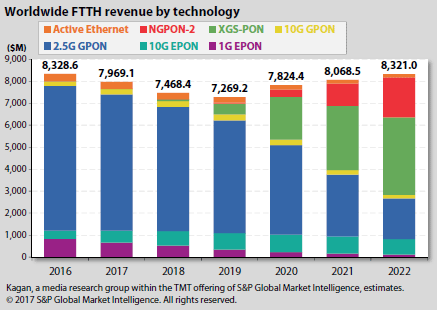
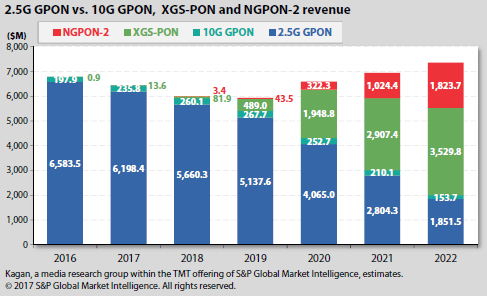
For operators with 1G EPON-based deployments — particularly Korea Telecom, Japan‘s NTT DOCOMO access, China Telecom and China Unicom, 10G EPON is quickly becoming the next-generation technology of choice for providing both asymmetric and symmetric 10 Gbps services. 10G EPON equipment shipments and revenue continue to grow, driven currently by China Telecom, which is in the process of upgrading a portion of its first-generation 1G networks to provide more bandwidth to multi-dwelling units, or MDUs.
Longer-term, cable operators in North America and Western Europe will deploy 10G EPON in Greenfield deployments and, on occasion, in overbuild situations, as well as for business services. Of course, MSOs will rely heavily on DOCSIS 3.1 for the bulk of their residential deployments. But 10G EPON will also be an important technology for cable operators for MDU deployments and business services, particularly as fiber is pushed deeper into the network and remote nodes are converted into OLTs.
Our equipment revenue forecasts for 10G EPON have been nearly doubled, due largely to higher-than-expected spending levels seen in 2016 in China, but also due to our expectations that a growing number of cable operators will mix in a higher percentage of 10G EPON for greenfield FTTH buildouts. Altice USA, Inc. has already committed to a full FTTH network buildout across its footprint, which we have now factored into our forecasts. In addition, we expect other North American MSOs to slowly migrate to 10G EPON for both their business and greenfield residential access networks.
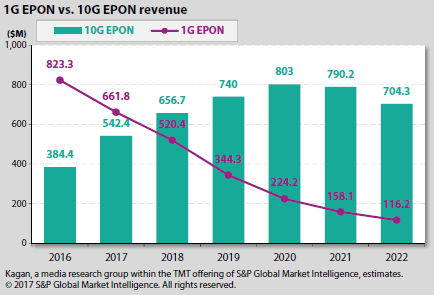
VDSL and G.fast spending to sustain DSL infrastructure market through 2019
Global spending on DSL equipment by operators and ISPs is expected to increase by 1.4% this year, with 2017 equipment revenue now expected to rise to $1.46 billion. The primary reason for the increase is a resumption in spending in the CALA region, which saw 2016 equipment revenue plummet to $75.8 million. Economic uncertainty in the region, as well as a decision by Telmex to halt its VDSL rollouts helped to push revenue down sharply in the region. We now expect DSL spending to reach normal annual levels, with 2017 revenue to reach $117.5 million.
Outside of CALA, declines are once again expected this year in North America, where total DSL revenue is expected to drop from $388.3 million in 2016 to $368.9 million in 2017. AT&T’s continued shift for its U-Verse service from very high bit rate digital subscriber line generation 2 (VDSL2) GPON is expected to result in a decline of another 600,000 VDSL ports from 2016 to 2017.
EMEA remains the world’s largest market for DSL infrastructure: 47.2% of global revenue comes from this region, where incumbents such as British Telecom (BT), Deutsche Telekom AG (DT), Orange SA, Telefonica and others continue to rely on asymmetric digital subscriber line (ADSL) and VDSL technologies for the bulk of their residential broadband service offerings. Providers have shifted a small percentage of their broadband networks to FTTH and will continue to do so. However, the cost of widespread fiber deployments, as well as line-sharing obligations will keep the bulk of broadband connections in this region copper-based. Throughout our forecast, the EMEA region will constitute 46% to 48% of global DSL revenue and will continue to be the leading region for G.fast deployments.
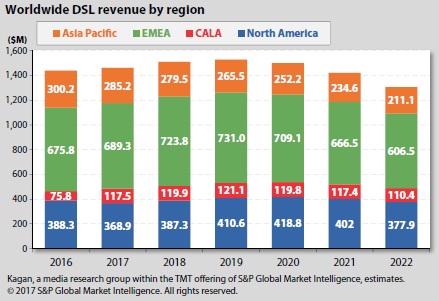
Along with the revenue increase expected in 2017, total DSL ports should also increase from 54.8 million in 2016 to 58.3 million. Further increases in total ports are expected through 2020, as service providers continue to shift away from ADSL/ADSL2+ technologies to VDSL2, VDSL Profile 35b and G.fast. From 2021 forward, however, we do expect the total market for DSL ports will decline, as more operators switch to FTTH as a logical progression from their deep fiber deployments to support VDSL2 and G.fast deployments.
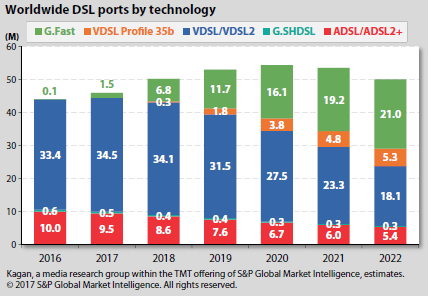
G.fast, a high-frequency DSL protocol designed for copper loops of 250 meters that can deliver between 150 Mbps and 1Gbps, will be relied upon by BT, Orange, Telekom Austria Group, AT&T and others in the coming years. CenturyLink already announced a 44-building G.fast deployment in Platteville, Wis. CenturyLink is expected to continue its G.fast deployments throughout 2017 and beyond. But BT is expected to drive the most G.fast port and customer premises equipment (CPE) shipments, with its announced plan to pass 10 million homes with G.fast by 2020.
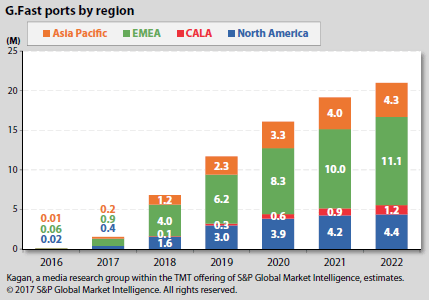
Until G.fast silicon chips, infrastructure and compatible CPE products are available in volume, VDSL2 will remain the workhorse technology. Vectored VDSL2 can provide 100 Mbps to 150 Mbps service over copper loops of 500 meters and has been used by a large number of operators in North America, EMEA and CALA to remain competitive with fiber over builders and cable operators.
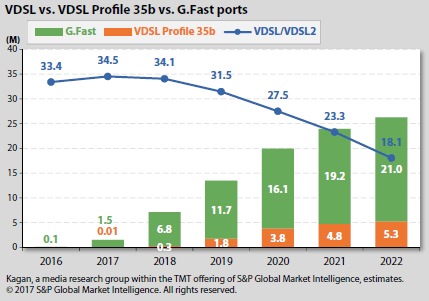
VDSL profile 35b, alternately called Super VDSL or Vplus, provides a niche solution between vectored VDSL2 and G.fast. At loop lengths between 250 and 500 meters, VDSL profile 35b can provide speeds ranging from 200 Mbps to 300 Mbps. Germany‘s DT is the leading proponent of this technology, as the operator has yet to deploy a significant amount of vectored VDSL2 and can therefore more cost-effectively make the transition to the 30 MHz vectoring of profile 35b. Additionally, DT has a large percentage of copper lengths within the 250 to 500 meter range, making it the ideal target for this technology.
Reference:
SNL Kagan: Sobering results from study of 88 municipal fiber networks in U.S.
By Sarah Barry James
There is a dearth of good data around municipal broadband networks, and the data that is available raises some tough questions.
A new study from University of Pennsylvania Law School Professor Christopher Yoo and co-author Timothy Pfenninger, a law student, identified 88 municipal fiber projects across the country, 20 of which report the financial results of their broadband operations separately from the results of their electric power operations. Municipal broadband networks are owned and operated by localities, often in connection with the local utility.
Of those 20, during a five-year period from 2010 to 2014, 11 were cash-flow negative, meaning they did not generate enough cash to cover their current operating costs. Of the nine that were cash flow positive, five were generating returns so small that it would take more than a century to recover project costs.
In his report, Yoo and Pfenninger called the results “sobering.”
“Many cities managing these projects have faced defaults, reductions in bond ratings, and ongoing liability,” the pair wrote, noting that city officials considering a municipal broadband project must “carefully assess all of these costs and risks” before moving forward.
Yet Christopher Mitchell, director of the Community Broadband Networks Initiative at the Institute for Local Self-Reliance, argued that Yoo’s study did not present an entirely accurate or up-to-date picture of U.S. municipal networks.
“When I looked at the 20 communities that he studied — and his methodology for picking those is totally reasonable and he did not cherry pick them — I was not surprised at his results because many of those networks are either in very small communities … and the others were often in the early years of a buildout during a period of deep recession,” Mitchell said.

An EPB crew lays fiber in Chattanooga, TN Image Courtesy of EPB
……………………………………………………………………………………………………………………………………
As an example, Mitchell pointed to Electric Power Board‘s municipal broadband network in Chattanooga, Tenn. — one of the five networks Yoo identified as having positive cash flow but at such a low level that it would take more than 100 years to recover project costs.
Specifically, Yoo found EPB’s fiber operations were cash-flow positive by roughly $2 million from 2010 to 2014, whereas the city had used $162 million in local revenue bonds to fund the fiber build-out. Given the costs versus the cash flow, Yoo estimated it would take 412 years to repay the project cost, though he noted EPB’s fiber network is “relatively young, and revenue grew at a healthy 41% annual rate from 2010 to 2014.”
EPB, however, disagrees with Yoo’s calculations. To begin, the company notes the fiber build-out was largely done to support the electric utility’s smart grid project. As a result, the debt for that project was divided between the electric business and the fiber business. Importantly, earlier this month, EPB CFO Greg Eaves announced the fiber business had fully paid down its debt to zero.
“Our fiber-optic portion of the debt is, in fact, paid. There is additional debt related to the smart grid project that’s still within the electric system to pay, but … the fiber-optic system generates enough revenue on an annual basis to more than cover the debt service for the electric system,” J.Ed. Marston, EPB’s vice president of marketing, said in a May 25 interview.
He noted that the fiber-optics business’ repayment had happened much faster than anticipated as consumer acquisition rates exceeded expectations. The company currently counts more than 90,000 residential and business customers, well above the 35,000 fiber-optics customers that had been projected.
“We were very, very conservative in the business plan,” Mike Kaiser, EPB assistant vice president of finance and controller, said in an interview.
Kaiser also noted that the fiber-optic business will pay $13.5 million in access fees to the electric business in 2017, in addition to $24.3 million in expense allocations. As a result, all electric system customers benefit from revenue generated by fiber-optics subscription sales.
In fact, without the revenue generated by the fiber-optics business, EPB estimated it would have had to raise electric rates by 7% this year.
According to Mitchell, Yoo’s study captured the Chattanooga network when it was still “small and growing,” but misses “what’s going to happen for the rest of the life of the network, which I think is the more important part.”
In an interview, Yoo explained the time frame of the study, 2010 to 2014, had been determined by the most recent data available when the study began. Further, he noted that the municipal networks included in the study covered a range of ages.
“The oldest one was 14 years old as of 2014, so we have real world performance from different ages of projects, from brand new to 14 years old. And we will continue to get more information about them as we go,” he said.
Yoo also noted, “Every paper can’t be everything to everybody.” In the case of his study, he decided to target it toward mayors and city council members who may be considering whether to build a fiber-optic network.
“So a lot of it is focusing on the financial impacts on city budgets,” he said, adding that he is not telling local officials what they should or should not do, but rather trying to provide as much information as possible so that officials can make informed decisions.
Yoo’s study also intentionally does not include the impact of higher tax revenues or job creation, which might offset project costs. But that, he said, is something municipalities should consider.
“There are benefits of broader economic activity that don’t accrue to the city — that’s good for the citizens, but the city is still going to have to finance that debt,” Yoo said. “So if I were a city council person, if the benefits really go to the city generally, we should be financing [the debt] through general revenues such as through sales tax, property tax and income tax.”
At a May 24 presentation of Yoo’s study at Penn Law’s Center for Technology, Innovation and Competition, former Pennsylvania Gov. Ed Rendell said he viewed Yoo’s “wonderful paper as a springboard for a national discussion” on how to best to expand access to affordable high-speed broadband to all corners of the country.
According to Rendell, Yoo’s study gives “one side of the dilemma” — namely, the cost associated with doing something. The other side of the dilemma, he noted, is the cost of doing nothing.
“The cost of doing something, meaning building your own municipal fiber network, is almost prohibitive and incredibly risky,” he said.
But the cost of doing nothing, he noted, could be equally high.
“What business … is going to go to a town that doesn’t have internet access?” Rendell said, noting that balancing these costs is “not so easy.”
References:
https://www.law.upenn.edu/live/files/6611-report-municipal-fiber-in-the-united-states
https://muninetworks.org/communitymap
https://www.fiberbroadband.org/page/ftth-newsroom
https://motherboard.vice.com/en_us/article/chattanooga-gigabit-fiber-network
http://www.chattanoogagig.com/
http://www.fiercetelecom.com/telecom/comcast-s-chattanooga-gbps-moves-raised-by-epb-s-presence
Wireline Phone Losses Continue into 1stQ-2017; Telco VoIP >PSTN Subscribers
By Chris Young and Kamran Asaf of SNL Kagan
Losses in wireline phone subscribers picked up steam in the first quarter of 2017 as a lackluster performance by cable operators failed to offset declines from telcos. According to company reports and estimates from SNL Kagan, a media research group within S&P Global Market Intelligence, wireline phone providers lost 763,000 subscribers in aggregate during the quarter, a 40% steeper drop than the loss experienced in the first quarter of 2016.
Cable’s share of the shrinking sector creeped up to 45.2%, 2.5 percentage points over the year-ago quarter.
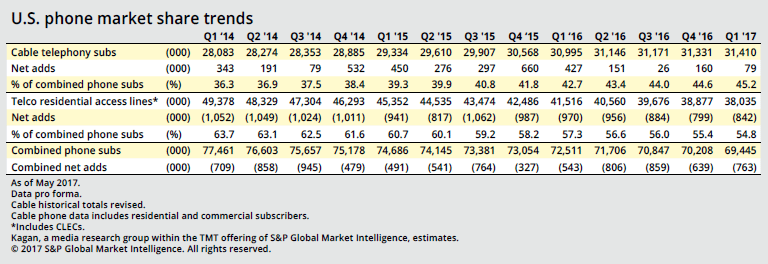
New commercial subscriber information released by Comcast allows us to delve deeper into the segment. As expected, commercial services boosted cable’s voice segment as residential uptake falters. In some quarters, commercial voice gains offset declining residential voice losses at the operator.
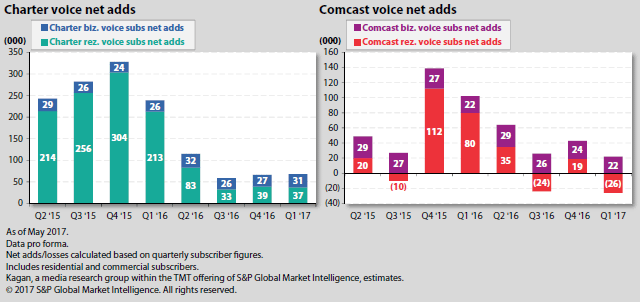
Charter is not immune to declining net additions. The operator’s voice net adds dipped considerably since closing its Time Warner Cable Inc./Bright House Networks LLC acquisitions. The operator faces a tough task overcoming churn at legacy Time Warner Cable systems, in part driven by its low-priced promotional voice offering in prior-year quarters.
Both Charter and Comcast are actively looking to deploy wireless telecom services by activating their mobile virtual network operator agreements with Verizon Communications Inc.‘s Verizon Wireless. While Charter expects to launch its service sometime in 2018, Comcast started taking sign-ups for Xfinity Mobile around mid-May. Comcast’s base offering starts at either $45 per month or $12 per gigabit of data consumed, according to the operator’s website.
Telco phone subscriptions:
The combined VoIP phone subs for AT&T Inc. and Verizon reached 9.4 million at the end of the first quarter and topped legacy circuit-switched subs by 511,000 as the traditional copper footprint contracted through upgrades and subscriber defections.
The telco sector has shown steady improvement of its fiber-deep phone penetration. AT&T and Verizon boosted combined IP voice penetration to over 51%, compared to 46% a year ago.
Despite losses in both IP and traditional voice subscribers in the quarter, FiOS improved its IP ratio with traditional subs to 54%, compared to AT&T U-verse’s 50% mix with traditional AT&T subs.
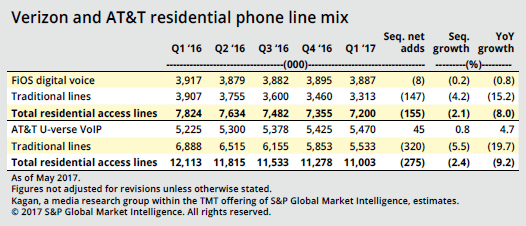
AT&T U-verse phone gained 45,000 subs in the quarter, compared to a gain of 13,000 for the same period in 2016. The IP phone segment has been affected by stalled broadband growth linked to losses of bundled U-verse video subscribers while the company shifts its video focus to DIRECTV Group Holdings LLC. The company ended the quarter with 5.5 million IP voice subs. Overall wireline phone subscribers were down 9.2% compared to first quarter of 2016 after factoring in circuit-switched subscriber losses.
FiOS IP-voice growth stalled as subs decreased slightly to just below 3.9 million at the end of the first quarter. Similar to AT&T, Verizon’s combined IP and traditional phone line subscribers were down. Verizon’s wireline phone subscribers dropped 8% year over year to 7.2 million subscribers due to traditional phone line losses.
AT&T and Verizon posted total residential access line losses to end the year with a combined 18.2 million.
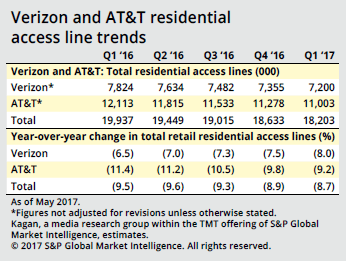
CenturyLink/Level 3 Says Its Fiber Assets will attract SMBs

“In the areas where we are the local exchange carrier, there’s a tremendous opportunity to take some market share away from the cable companies, especially small to mid-sized customers where Qwest had lost quite a bit of market share,” Ewing said.
Sunit Patel, CFO of Level 3, said that the new on-net fiber footprint will give the new company an advantage of cable competitors.
“When you look at our on-net fiber building footprint as a combined company it’s quite substantial,” Patel said. “There’s absolutely no reason why we should not be able to compete against the cable companies in those buildings.”
Patel added that CenturyLink has potential to advance its market share with a larger set of services in these buildings with a larger fiber network.
“When you look at the market share penetration in those buildings, it is reasonably low so there are opportunities for market share gains there,” Patel said. “The proximity of our network to a lot of buildings is better as a combined company so if you leverage that we’ll be able to compete quite effectively against cable companies.”
References:
https://jpmorgan.metameetings.net/events/tmt17/sessions/12433-centurylink-inc-level-3-communications/webcast


